Common Towing Definitions
The following trailer towing related definitions will assist you in understanding the following information:
Gross Vehicle Weight Rating (GVWR)
The GVWR is the total allowable weight of your vehicle. This includes driver, passengers, cargo and tongue weight. The total load must be limited so that you do not exceed the GVWR VEHICLE LOADING.
Gross Trailer Weight (GTW)
The GTW is the weight of the trailer plus the weight of all cargo, consumables and equipment (permanent or temporary) loaded in or on the trailer in its "loaded and ready for operation" condition.
The recommended way to measure GTW is to put your fully loaded trailer on a vehicle scale. The entire weight of the trailer must be supported by the scale.
If the gross trailer weight is 5,000 lb (2,267 kg) or more, it is recommended to use a weight-distributing hitch to ensure stable handling of your vehicle. If you use a standard weight-carrying hitch, you could lose control of your vehicle and cause a collision.
Gross Combination Weight Rating (GCWR)
The GCWR is the total allowable weight of your vehicle and trailer when weighed in combination.
Gross Axle Weight Rating (GAWR)
The GAWR is the maximum capacity of the front and rear axles. Distribute the load over the front and rear axles evenly. Make sure that you do not exceed either front or rear GAWR VEHICLE LOADING.
It is important that you do not exceed the maximum front or rear GAWR. A dangerous driving condition can result if either rating is exceeded. You could lose control of the vehicle and have a collision.
Tongue Weight (TW)
The TW is the downward force exerted on the hitch ball by the trailer. You must consider this as part of the load on your vehicle.
Trailer Frontal Area
The frontal area is the maximum height multiplied by the maximum width of the front of a trailer.
Trailer Sway Control (TSC)
The TSC can be a mechanical telescoping link that can be installed between the hitch receiver and the trailer tongue that typically provides adjustable friction associated with the telescoping motion to dampen any unwanted trailer swaying motions while traveling.
If equipped, the electronic TSC recognizes a swaying trailer and automatically applies individual wheel brakes and/or reduces engine power to attempt to eliminate the trailer sway.
Weight-Carrying Hitch
A weight-carrying hitch supports the trailer tongue weight, just as if it were luggage located at a hitch ball or some other connecting point of the vehicle. These kinds of hitches are used to tow small and medium sized trailers.
Weight-Distributing Hitch
A Weight-Distributing Hitch system works by applying leverage through spring (load) bars. They are typically used for heavier loads to distribute trailer tongue weight to the tow vehicle's front axle and the trailer axle(s). When used in accordance with the manufacturer's directions, it provides for a more level ride, offering more consistent steering and brake control thereby enhancing towing safety. The addition of a friction/hydraulic sway control also dampens sway caused by traffic and crosswinds and contributes positively to tow vehicle and trailer stability. Trailer sway control and a weight-distributing (load equalizing) hitch are recommended for heavier Tongue Weights (TW) and may be required depending on vehicle and trailer configuration/loading to comply with Gross Axle Weight Rating (GAWR) requirements.
An improperly adjusted Weight-Distributing Hitch system may reduce handling, stability, braking performance, and could result in a collision.
Weight-Distributing Hitch systems may not be compatible with surge brake couplers. Consult with your hitch and trailer manufacturer or a reputable Recreational Vehicle dealer for additional information.
Recommended Distribution Hitch Adjustment — Quadra-Lift Air Suspension Equipped Vehicles
Verify that the vehicle is at the Normal Ride Height.
Note:The vehicle must remain in the RUN position with all doors closed while attaching a trailer for proper leveling of the air suspension system.
Position the vehicle on a level surface in preparation to connect to the trailer (do not connect the trailer).
For vehicles equipped with Quadra-Lift air suspension, use the touchscreen radio settings to enable Tire/Jack mode. Tire/Jack mode will be canceled and the procedure must be restarted if the vehicle is driven at speeds above 5 mph (8 km/h). When towing, the automatic Entry/Exit feature may be disabled through the Uconnect Touchscreen Radio to prevent vehicle and trailer movement when gear selector is moved to PARK.
Measure the height from the top of the front wheel opening on the fender to the ground; this is height H1.

Measuring Height (H)
Attach the loaded trailer to the vehicle without the weight distribution bars connected.
Measure the height from the top of the front wheel opening on the fender to the ground; this is height H2.
Install and adjust the tension in the weight-distributing bars per the manufacturers’ recommendations so that the height of the front fender is approximately (H2-H1)/2+H1 (about 1/2 the difference between H2 and H1 above normal ride height [H1]).
Use the touchscreen radio settings and switch off Tire/Jack mode. Make sure the vehicle returns to Normal Ride Height. Perform a visual inspection of the trailer and weight-distributing hitch to confirm the manufacturers’ recommendations have been met.
The vehicle can now be driven.
| Measurement Example | Example Height (mm) |
|---|---|
| H1 | 925 |
| H2 | 946 |
| H2-H1 | 21 |
| (H2-H1)/2 | 10.5 |
| (H2-H1)/2 + H1 | 935.5 |
For all towing conditions, we recommend towing with TOW/HAUL mode engaged (if equipped).
Recommended Distribution Hitch Adjustment — Non-Air Suspension Equipped Vehicles
Verify that the vehicle is at the normal ride height.
Position the vehicle on a level surface in preparation to connect to the trailer (do not connect the trailer).
Measure the height from the top of the front wheel opening on the fender to the ground; this is height H1.

Measuring Height (H)
Attach the loaded trailer to the vehicle without the weight distribution bars connected.
Ensure the trailer is properly secured to the hitch, including the safety chains, lighting, and trailer brake controls.
Cautiously drive the vehicle and trailer at 20-25 mph (30-40 km/h) for approximately 3 miles (5 km) to re-level the suspension.
Park the vehicle and trailer on a level surface.
Measure the height from the top of the front wheel opening on the fender to the ground; this is height H2.
Install and adjust the tension in the weight-distributing bars per the manufacturers’ recommendations so that the height of the front fender is approximately (H2-H1)/2+H1 (about 1/2 the difference between H2 and H1 above normal ride height [H1]).
Perform a visual inspection of the trailer and weight-distributing hitch to confirm the manufacturers’ recommendations have been met.
The vehicle can now be driven.
| Measurement Example | Example Height (mm) |
|---|---|
| H1 | 925 |
| H2 | 946 |
| H2-H1 | 21 |
| (H2-H1)/2 | 10.5 |
| (H2-H1)/2 + H1 | 935.5 |
For all towing conditions, we recommend towing with TOW/HAUL mode engaged (if equipped).
Trailer Hitch Classification
The following chart provides the industry standard for the maximum trailer weight a given trailer hitch class can tow and should be used to assist you in selecting the correct trailer hitch for your intended towing condition.
Trailer Hitch Classification Definitions | |
|---|---|
Class | Max. Trailer Hitch Industry Standards |
Class I - Light Duty | 2,000 lb (907 kg) |
Class II - Medium Duty | 3,500 lb (1,587 kg) |
Class III - Heavy Duty | 6,000 lb (2,722 kg) |
Class IV - Extra Heavy Duty | 10,000 lb (4,535 kg) |
Refer to the “Trailer Towing Weights (Maximum Trailer Weight Ratings)” chart for the Maximum Gross Trailer Weight (GTW) towable for your given drivetrain. | |
All trailer hitches should be professionally installed on your vehicle. | |
Trailer Towing Weights (Maximum Trailer Weight Ratings)
Engine | Model | GCWR | Frontal Area | Maximum GTW | Maximum TW |
|---|---|---|---|---|---|
3.0L High Output | 4x2 | 12,300 lb (5,579 kg) | 40 sq ft (3.72 sq m) | 5,850 lb (2,653 kg) | 585 lb (265 kg) |
3.0L High Output | 4x2 Max Tow | 16,500 lb (7,484 kg) | 60 sq ft (5.57 sq m) | 10,000 lb (4,536 kg) | 1,000 lb (454 kg) |
3.0L High Output | 4x4 | 12,300 lb (5,579 kg) | 40 sq ft (3.72 sq m) | 5,630 lb (2,553 kg) | 563 lb (255 kg) |
3.0L High Output | 4x4 Max Tow | 16,500 lb (7,484 kg) | 55 sq ft (5.11 sq m) | 9,840 lb (4,463 kg) | 984 lb (446 kg) |
5.7L | 4x2 Series 3 (3.21 Axle Ratio) | 13,700 lb (6,214 kg) | 40 sq ft (3.72 sq m) | 7,400 lb (3,356 kg) | 740 lb (335 kg) |
5.7L | 4x2 Series 3 (3.92 Axle Ratio) | 15,000 lb (6,803 kg) | 60 sq ft (5.57 sq m) | 10,000 lb (4,536 kg) | 1,000 lb (454 kg) |
5.7L | 4x2 Series 2 (3.21 Axle Ratio) | 15,000 lb (6,803 kg) | 55 sq ft (5.11 sq m) | 8,790 lb (3,987 kg) | 879 lb (398 kg) |
5.7L | 4x2 Series 2 (3.92 Axle Ratio) | 16,600 lb (7,529 kg) | 60 sq ft (5.57 sq m) | 10,000 lb (4,536 kg) | 1,000 lb (454 kg) |
5.7L | 4x4 Series 1 (3.21 Axle Ratio) | 13,700 lb (6,214 kg) | 40 sq ft (3.72 sq m) | 7,180 lb (3,256 kg) | 718 lb (325 kg) |
5.7L | 4x4 Series 1 (3.92 Axle Ratio) | 15,000 lb (6,803 kg) | 55 sq ft (5.11 sq m) | 8,480 lb (3,846 kg) | 848 lb (386 kg) |
5.7L | 4x4 Series 2 (3.21 Axle Ratio) | 13,700 lb (6,214 kg) | 40 sq ft (3.72 sq m) | 7,170 lb (3,252 kg) | 717 lb (325 kg) |
5.7L | 4x4 Series 2 (3.92 Axle Ratio) | 16,600 lb (7,529 kg) | 60 sq ft (5.57 sq m) | 10,000 lb (4,536 kg) | 1,000 lb (454 kg) |
5.7L | 4x4 Series 3 (3.21 Axle Ratio) | 13,700 lb (6,214 kg) | 40 sq ft (3.72 sq m) | 7,170 lb (3,252 kg) | 717 lb (325 kg) |
5.7L | 4x4 Series 3 (3.92 Axle Ratio) | 15,000 lb (6,803 kg) | 55 sq ft (5.11 sq m) | 8,470 lb (3,841 kg) | 847 lb (384 kg) |
6.4L | 4x2 | 15,000 lb (6,803 kg) | 55 sq ft (5.11 sq m) | 8,450 lb (3,832 kg) | 845 lb (383 kg) |
6.4L | 4x2 Max Tow | 16,600 lb (7,529 kg) | 60 sq ft (5.57 sq m) | 10,000 lb (4,536 kg) | 1,000 lb (454 kg) |
6.4L | 4x4 | 15,000 lb (6,803 kg) | 55 sq ft (5.11 sq m) | 8,260 lb (3,746 kg) | 826 lb (374 kg) |
6.4L | 4x4 Max Tow | 16,600 lb (7,529 kg) | 55 sq ft (5.11 sq m) | 9,860 lb (4,472 kg) | 986 lb (447 kg) |
Refer to local laws for maximum trailer towing speeds. | |||||
Trailer Hitch Receiver Cover Removal — If Equipped
Your vehicle may be equipped with a trailer hitch receiver cover, this must be removed to access the trailer hitch receiver. This cover is located at the bottom center of the rear fascia/bumper.
Turn the three locking retainers located at the bottom of the hitch receiver cover a quarter turn counterclockwise and pull bottom of the hitch receiver cover outward (towards you).
Pull the bottom of the cover outward (towards you) then downwards to disengage the tabs located at the top of the hitch receiver cover to remove.
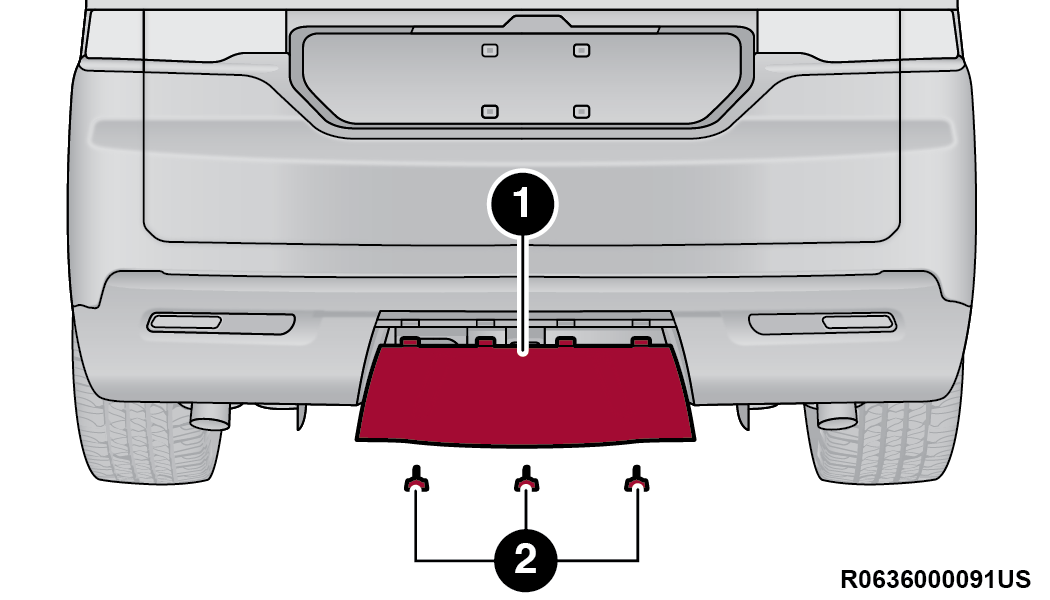
Hitch Receiver Cover
1 — Hitch Receiver Cover 2 — Locking Retainers
To reinstall the cover after towing repeat the procedure in reverse order.
Be sure to engage all tabs and fully seat the hitch receiver cover in the fascia/bumper prior to installation of the quarter turn fasteners.
Trailer And Tongue Weight
Never exceed the maximum tongue weight stamped on your bumper or trailer hitch.
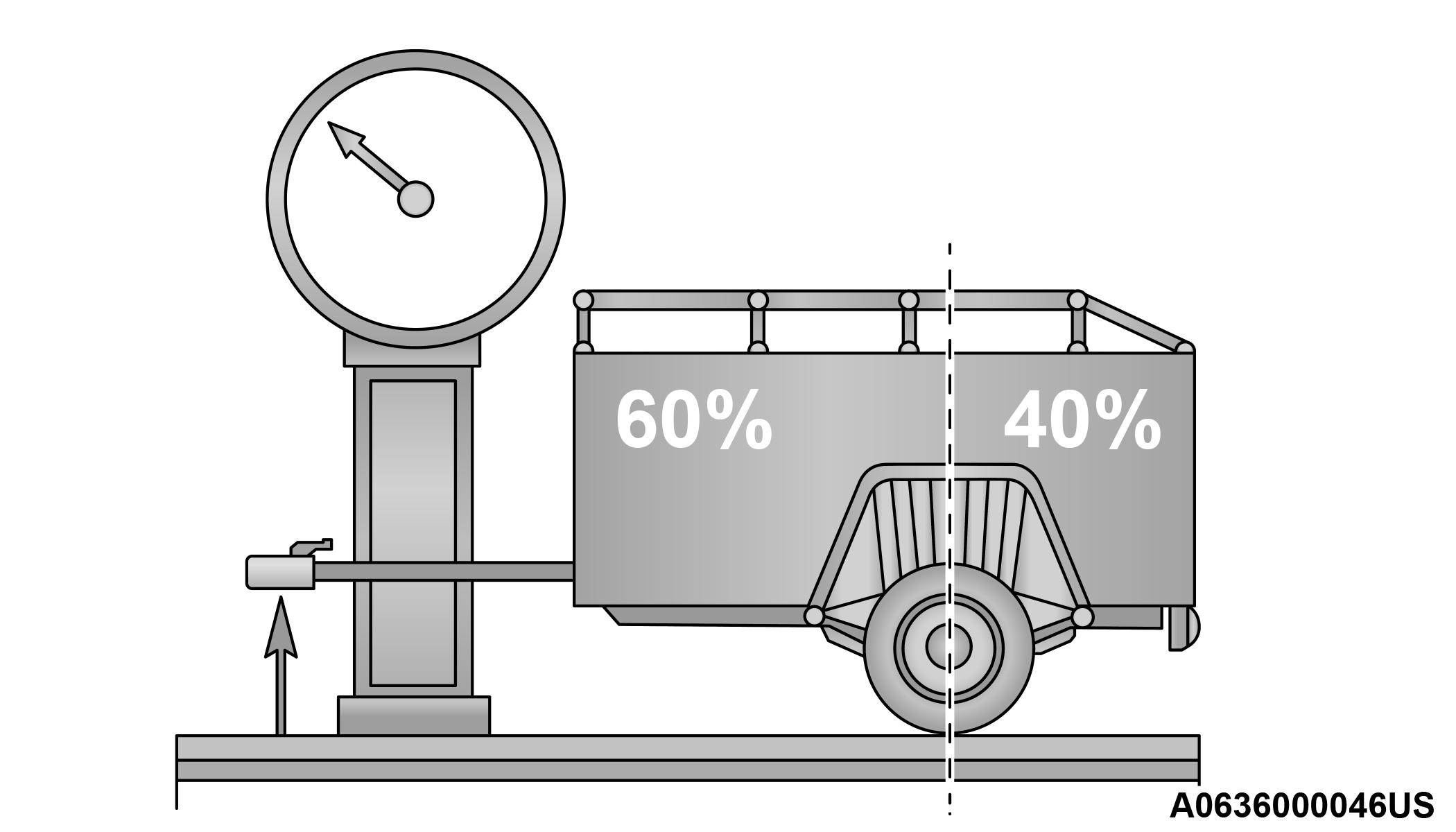
Weight Distribution
Always load a trailer with 60% of the weight in the front of the trailer. This places 10% of the GTW on the tow hitch of your vehicle. Loads balanced over the wheels or heavier in the rear can cause the trailer to sway severely side to side which will cause loss of control of the vehicle and trailer. Failure to load trailers heavier in front is the cause of many trailer collisions.
Consider the following items when computing the weight on the rear axle of the vehicle:
The tongue weight of the trailer.
The weight of any other type of cargo or equipment put in or on your vehicle.
The weight of the driver and all passengers.
Remember that everything put into or on the trailer adds to the load on your vehicle. Also, additional factory-installed options or dealer-installed options must be considered as part of the total load on your vehicle. Refer to the “Tire And Loading Information” placard for the maximum combined weight of occupants and cargo for your vehicle.
Towing Requirements
To promote proper break-in of the new vehicle drivetrain components, the following guidelines are recommended.
Do not tow a trailer at all during the first 500 miles (805 km) the new vehicle is driven. The engine, axle or other parts could be damaged.
Then, during the first 500 miles (805 km) that a trailer is towed, do not drive over 50 mph (80 km/h) and do not make starts at full throttle. This helps the engine and other parts of the vehicle wear in at the heavier loads.
Perform the maintenance listed in the Scheduled Servicing SCHEDULED SERVICING. When towing a trailer, never exceed the GAWR or GCWR ratings.
Make certain that the load is secured in the trailer and will not shift during travel. When trailering cargo that is not fully secured, dynamic load shifts can occur that may be difficult for the driver to control. You could lose control of your vehicle and have a collision.
When hauling cargo or towing a trailer, do not overload your vehicle or trailer. Overloading can cause a loss of control, poor performance or damage to brakes, axle, engine, transmission, steering, suspension, chassis structure or tires.
Safety chains must always be used between your vehicle and trailer. Always connect the chains to the hook retainers of the vehicle hitch. Cross the chains under the trailer tongue and allow enough slack for turning corners.
Vehicles with trailers should not be parked on a grade. When parking, apply the parking brake on the tow vehicle. Put the tow vehicle transmission in PARK (P). For four-wheel drive vehicles, make sure the transfer case is not in NEUTRAL (N). Always, block or "chock" the trailer wheels.
GCWR must not be exceeded.
Total weight must be distributed between the tow vehicle and the trailer such that the following four ratings are not exceeded:
GVWR
GTW
GAWR
Tongue weight rating for the trailer hitch utilized
Towing Requirements — Tires
Do not attempt to tow a trailer while using a compact spare tire.
Do not drive more than 50 mph (80 km/h) when towing while using a full-size spare tire.
Proper tire inflation pressures are essential to the safe and satisfactory operation of your vehicle.
Check the trailer tires for proper tire inflation pressures before trailer usage.
Check for signs of tire wear or visible tire damage before towing a trailer.
Replacing tires with a higher load carrying capacity will not increase the vehicle's GVWR and GAWR limits.
For further information TIRES.
Towing Requirements — Trailer Brakes
Do not interconnect the hydraulic brake system or vacuum system of your vehicle with that of the trailer. This could cause inadequate braking and possible personal injury.
An electronically actuated trailer brake controller is required when towing a trailer with electronically actuated brakes. When towing a trailer equipped with a hydraulic surge actuated brake system, an electronic brake controller is not required.
Trailer brakes are recommended for trailers over 1,000 lb (453 kg) and required for trailers in excess of 2,000 lb (907 kg).
Do not connect trailer brakes to your vehicle's hydraulic brake lines. It can overload your brake system and cause it to fail. You might not have brakes when you need them and could have an accident.
Towing any trailer will increase your stopping distance. When towing, you should allow for additional space between your vehicle and the vehicle in front of you. Failure to do so could result in an accident.
If the trailer weighs more than 1,000 lb (453 kg) loaded, it should have its own brakes and they should be of adequate capacity. Failure to do this could lead to accelerated brake lining wear, higher brake pedal effort, and longer stopping distances.
Integrated Trailer Brake Module (ITBM) — If Equipped
Your vehicle may have an ITBM for Electric and Electric Over Hydraulic (EOH) trailer brakes. The controller is located below the instrument panel on the right side of the steering column.
This module has been designed and verified with electric trailer brakes and EOH systems. Some previous EOH systems may not be compatible with ITBM.
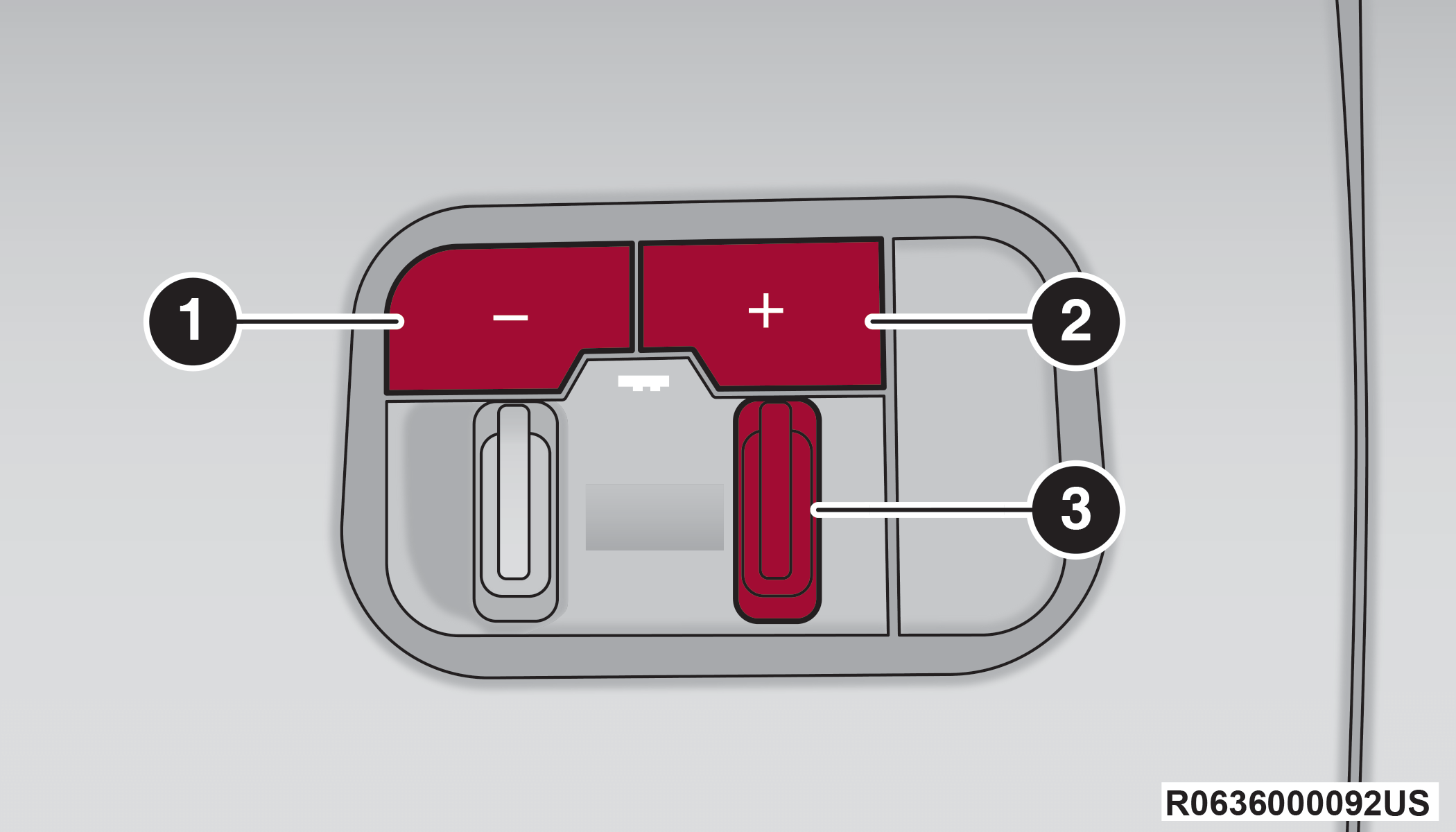
Integrated Trailer Brake Module (ITBM)
| 1 — GAIN Adjustment Button |
| 2 — GAIN Adjustment Button |
| 3 — Manual Brake Control Lever |
The user interface consists of the following:
Manual Brake Control Lever
Slide the manual brake control lever to the left to activate power to the trailer's electric brakes independent of the tow vehicle's brakes. If the manual brake control lever is activated while the brake is also applied, the greater of the two inputs determines the power sent to the trailer brakes.
The trailer and the vehicle's brake lamps will come on when either vehicle braking or manual trailer brakes are applied.
Trailer Brake Status Indicator Light
This light indicates the trailer electrical connection status.
If no electrical connection is detected after the ignition is turned on, pushing the GAIN adjustment button or sliding the manual brake control lever will display the GAIN setting for 10 seconds and the Trailer Brake Status Indicator Light will not be displayed.
If a fault is detected in the trailer wiring or the ITBM, the Trailer Brake Status Indicator Light will flash.
GAIN Adjustment Buttons (+/-)
Pushing these buttons will adjust the brake control power output to the trailer brakes in 0.5 increments. The GAIN setting can be increased to a maximum of 10 or decreased to a minimum of 0 (no trailer braking).
GAIN
The GAIN setting is used to set the trailer brake control for the specific towing condition and should be changed as towing conditions change. Changes to towing conditions include trailer load, vehicle load, road conditions and weather.
Adjusting GAIN
This should only be performed in a traffic free environment at speeds of approximately 20–25 mph (30–40 km/h).
Make sure the trailer brakes are in good working condition, functioning normally and properly adjusted. See a trailer dealer if necessary.
Hook up the trailer and make the electrical connections according to the trailer manufacturer's instructions.
When a trailer with electric/EOH brakes is plugged in, the trailer connected message should appear in the instrument cluster display (if the connection is not recognized by the ITBM, braking functions will not be available), the GAIN setting will illuminate and the correct type of trailer must be selected from the instrument cluster display options.
Push the UP or DOWN button on the steering wheel until “TRAILER TOW” appears on the screen.
Push the RIGHT arrow on the steering wheel to enter “TRAILER TOW”.
Push the UP or DOWN buttons until the “Trailer Brake Type” appears on the screen.
Push the RIGHT arrow and then push the UP or DOWN buttons until the proper Trailer Brake Type appears on the screen.
In a traffic-free environment, tow the trailer on a dry, level surface at a speed of 20–25 mph (30–40 km/h) and squeeze the manual brake control lever completely.
If the trailer wheels lockup (indicated by squealing tires), reduce the GAIN setting; if the trailer wheels turn freely, increase the GAIN setting.
Repeat steps 8 and 9 until the GAIN setting is at a point just below trailer wheel lockup. If towing a heavier trailer, trailer wheel lockup may not be attainable even with the maximum GAIN setting of 10.
Display Messages
The trailer brake control interacts with the instrument cluster display. Display messages, along with a single chime, will be displayed when a malfunction is determined in the trailer connection, trailer brake control, or on the trailer INSTRUMENT CLUSTER DISPLAY.
Connecting a trailer that is not compatible with the ITBM system may result in reduced or complete loss of trailer braking. There may be a increase in stopping distance or trailer instability which could result in personal injury.
Connecting a trailer that is not compatible with the ITBM system may result in reduced or complete loss of trailer braking. There may be a increase in stopping distance or trailer instability which could result in damage to your vehicle, trailer, or other property.
An aftermarket controller may be available for use with trailers with air or EOH trailer brake systems. To determine the type of brakes on your trailer and the availability of controllers, check with your trailer manufacturer or dealer.
Removal of the ITBM will cause errors and it may cause damage to the electrical system and electronic modules of the vehicle. See an authorized dealer if an aftermarket module is to be installed.
Towing Requirements — Trailer Lights And Wiring
Whenever pulling a trailer, regardless of the trailer size, stop lights and turn signals on the trailer are required for motoring safety.
The Trailer Tow Package may include a four- and seven-pin wiring harness. Use a factory approved trailer harness and connector.
Do not cut or splice wiring into the vehicle’s wiring harness.
The electrical connections are all complete to the vehicle but you must mate the harness to a trailer connector. Refer to the following illustrations.
Disconnect the trailer wiring connector from the vehicle (or any other device plugged into the vehicle’s electrical connectors) before launching a boat into water.
Be sure to reconnect once clear from water area.
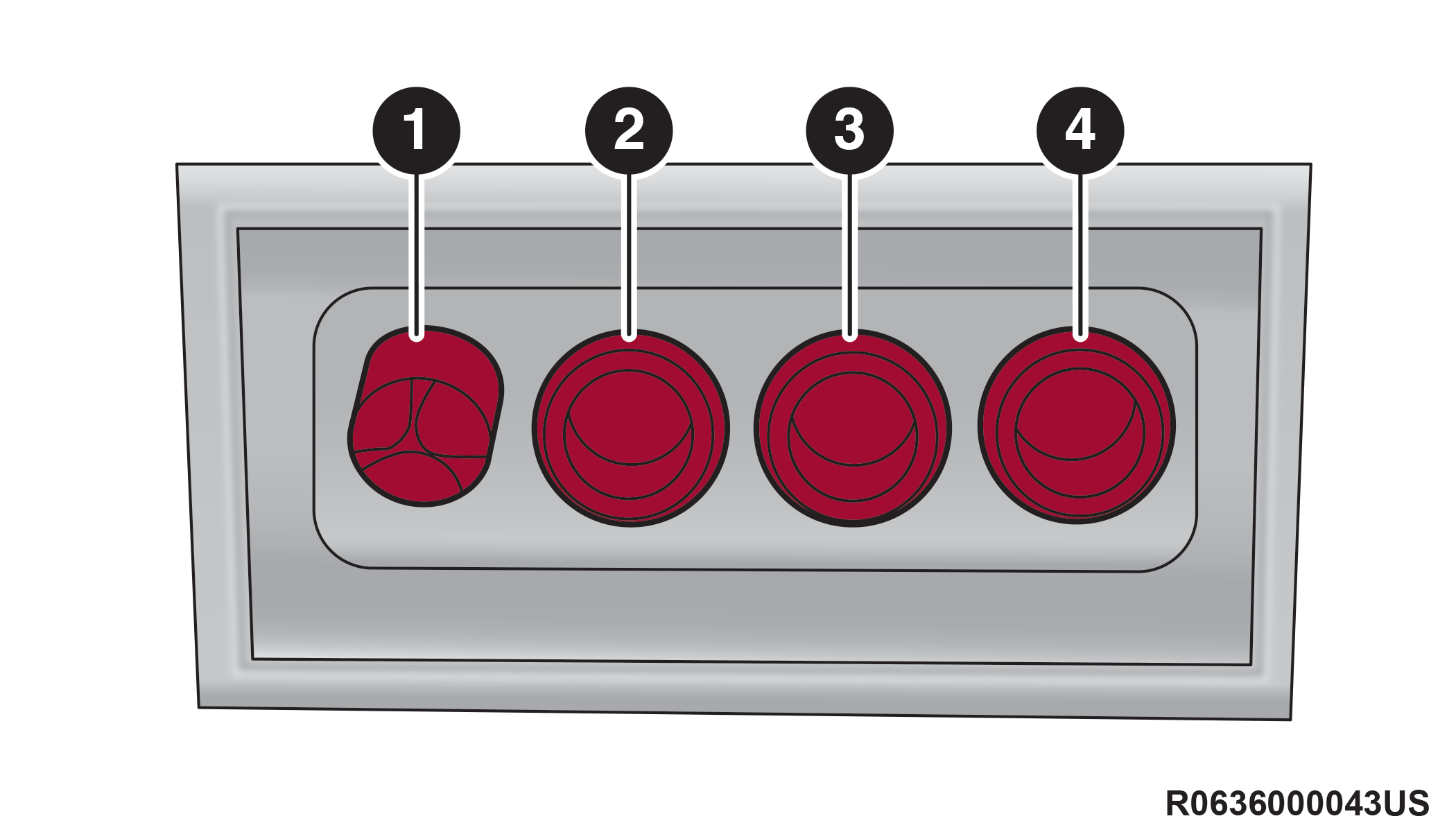
Four-Pin Connector
1 — Ground |
2 — Park |
3 — Left Stop/Turn |
4 — Right Stop/Turn |
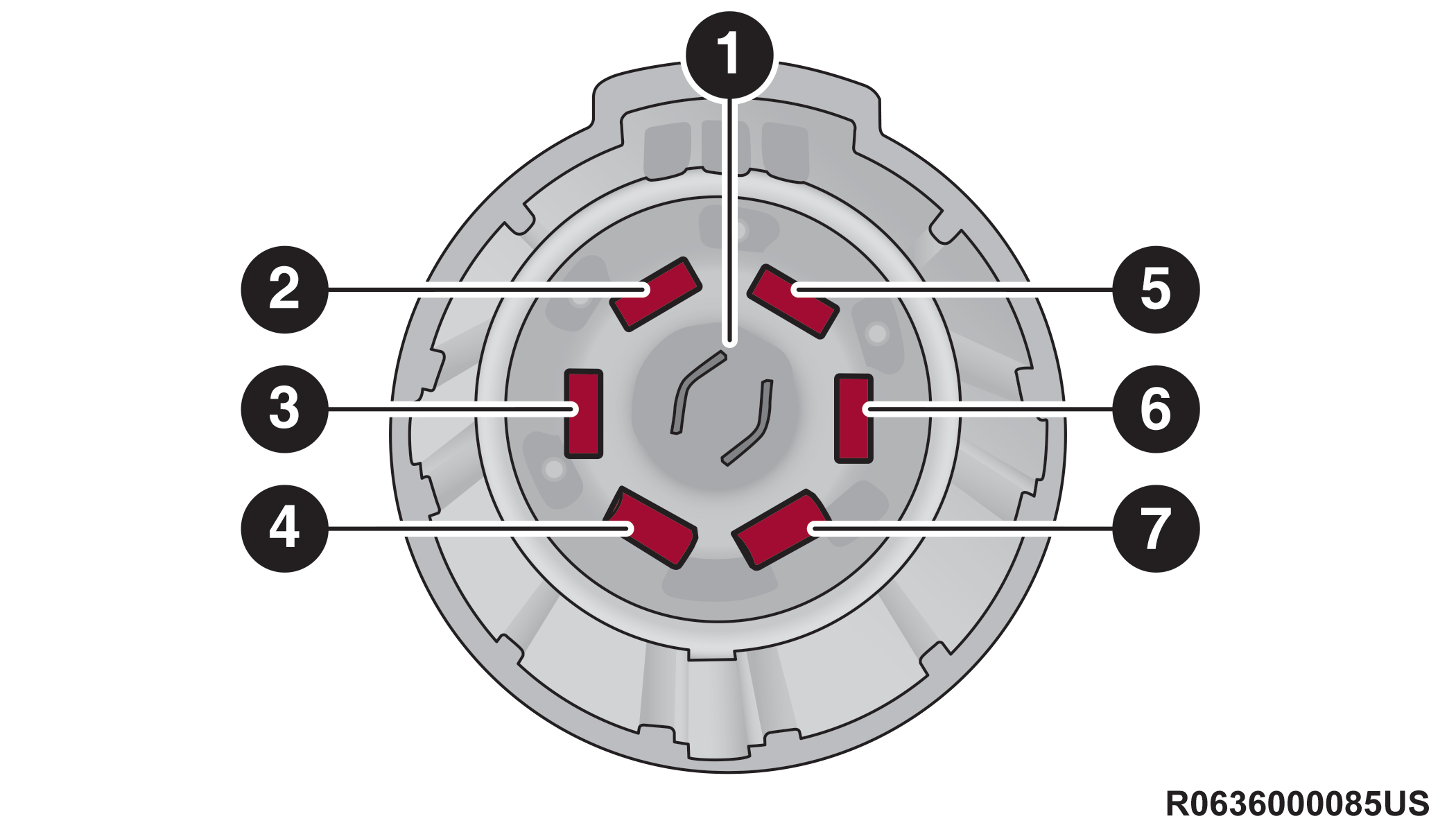
Seven-Pin Connector
1 — Backup Lamps |
2 — Running Lamps |
3 — Left Stop/Turn |
4 — Ground |
5 — Battery |
6 — Right Stop/Turn |
7 — Electric Brakes |
Towing Tips
Before towing, practice turning, stopping, and backing up the trailer in an area located away from heavy traffic. If equipped with Quadra-Lift air suspension, the automatic Entry/Exit feature may be disabled through the Uconnect Touchscreen Radio to prevent vehicle and trailer movement when gear selector is moved to PARK.
Automatic Transmission
Select the DRIVE (D) range when towing. The transmission controls include a drive strategy to avoid frequent shifting when towing. However, if frequent shifting does occur while in DRIVE, you can use the Electronic Range Select (ERS) shift control to manually select a lower gear.
Using a lower gear while operating the vehicle under heavy loading conditions, will improve performance and extend transmission life by reducing excessive shifting and heat build-up. This action will also provide better engine braking.
Cruise Control — If Equipped
Do not use on hilly terrain or with heavy loads.
When using the Cruise Control, if you experience speed drops greater than 10 mph (16 km/h), disengage until you can get back to cruising speed.
Use Cruise Control in flat terrain and with light loads to maximize fuel efficiency.